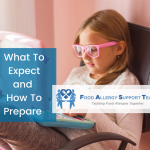Infant OIT
Oral Immunotherapy (OIT) has seen a great amount of progress over the last 10 years. As providers we have been able to work with patients and their families in not only preventing life-threatening anaphylaxis but also decreasing anxiety. As anything that is relatively new, we are constantly learning and advancing. One major consistency in OIT data is that children tend to ‘do better’ than adults. What this means is that overall, there are less adverse reactions and also the sIgE in children tends to decrease more than an adult going through the same program. Therefore, if a patient is considering OIT, I recommend they go through with the program instead of waiting a few more years.
Subcutaneous immunotherapy (allergy shots) for environmental allergens has been around for over 100 years. In this well-established treatment, 5 years of age is a common starting point mostly because children can adequately communicate and explain if they are having any symptoms. Most providers have opted to offer OIT to those age 5 and older because of the years of experience with subcutaneous immunotherapy. Slowly we, and many other providers, offered OIT down to age 3 if we felt the child could communicate any possible reactions. We, like many other allergists, have had a lot of success in these young children. Some brave and smart doctors most likely thought two things:
1) If OIT is better the younger you are, then how young can we go?
2) In general Anaphylaxis in infants is rarely, if ever fatal. Taking these points together, Infant OIT was started.
About 2 years ago at the American Academy of Allergy, Asthma and Immunology annual conference in San Francisco, a doctor presented data on infants he had been successfully desensitizing with OIT. The data showed that not only was the risk of OIT in infants very low, but also there is a greater chance in infants than any other age of actually ‘turning off’ rather than suppressing the food allergy. Because of this potentially life altering treatment, infant OIT has gained more attention. We are still following this data but are encouraged to ‘turn off’ this allergy in our patients meaning that they may not need a daily or even weekly maintenance dose and may not even need to carry an epi device in the future.
As a provider we have to be able to really take cues from the infants since they can’t communicate very well. Frequent exams by the provider as well as the parents during the up-dosing allows us to do this in a safe manner. There was a recent article in JACI Clinical Practice titled ‘Food-Induced Anaphylaxis in Infants: Can New Evidence Assist with Implementation of Food Allergy Prevention and Treatment?’ It gives a nice summary of what we have seen regarding the successes of Infant OIT. It ends with the following statement:
‘For treatment, OIT in infants and preschoolers holds exceptional promise due to better safety and efficiency, with additional advantages such as prevention of long-term psychosocial consequences such as anxiety, bullying, and poor quality of life. The future for interventions in infants that focus on regular, long-term ingestion rather than avoidance is brighter than it has ever been based on recent evidence.’
******************
Douglas F. McMahon, MD
Allergy and Asthma Center of Minnesota
www.allergymn.com





